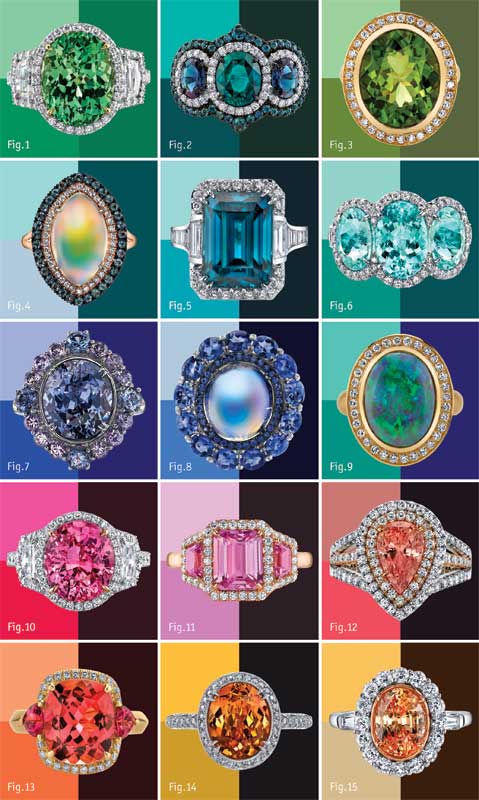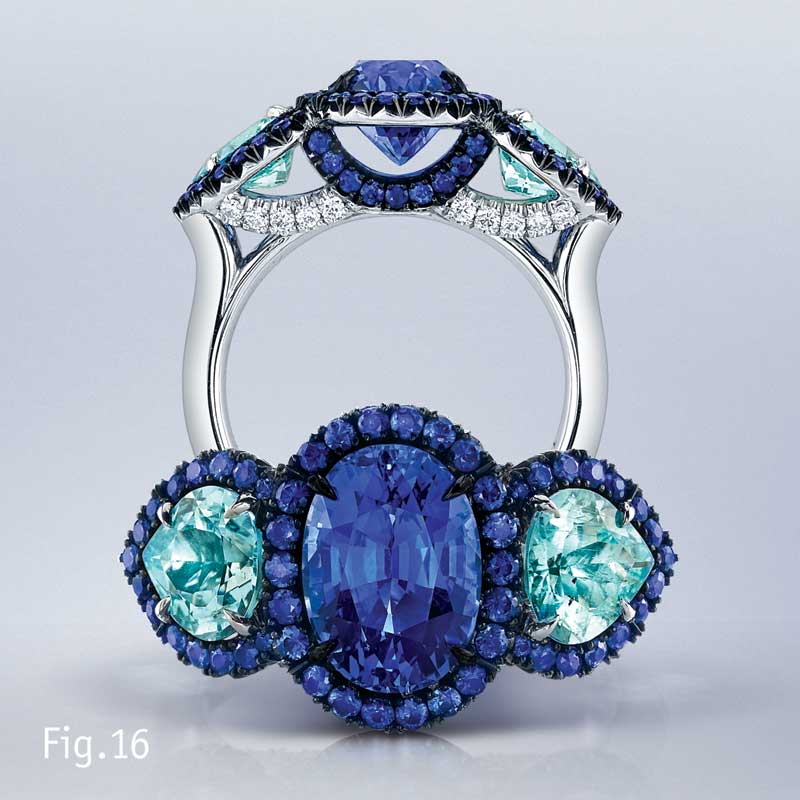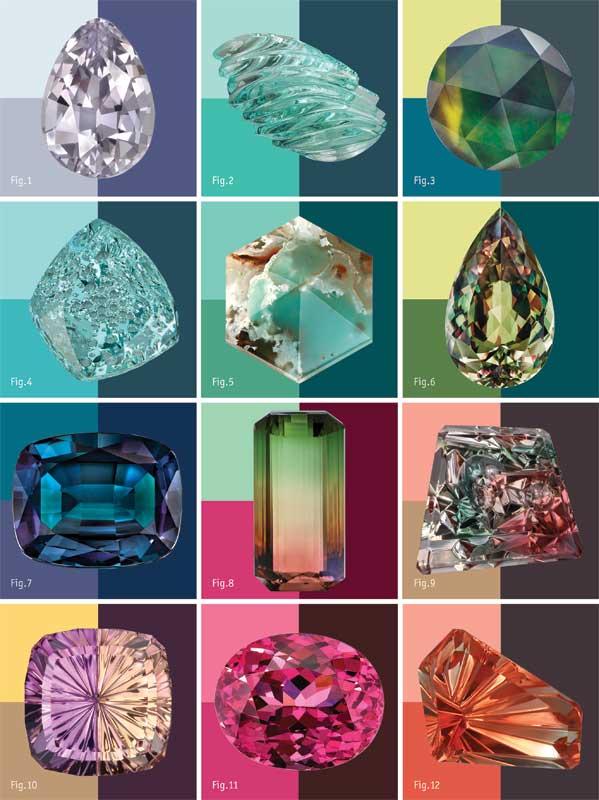2021 forecast colour palette: Coloured gems to look for in the new decade
June 1, 2020
By Katinka Champion

Ring Palette: The 2020 forecast colour palette ring collaboration with Omi Privé highlights some of the company’s designs. The hues in the palette are represented by a 6.77-carat Merelani mint garnet (Fig. 1); a 2.12-carat Madagascan grandidierite, accented by alexandrites (Fig. 2); a 11.81-carat peridot (Fig. 3); a 7.34-carat rainbow moonstone (Fig. 4); a 16.88-carat blue zircon (Fig. 5); a 3.24-carat Paraíba-type Mozambican tourmaline, accented by tourmalines (Fig. 6); a 8.02-carat lavender spinel, accented with round spinels (Fig. 7); a 11.17-carat moonstone, accented by buff-top sapphires (Fig. 8); a 5.37-carat Australian black opal (Fig. 9); a 7.67-carat pink sapphire (Fig. 10); a 2.73-carat pink sapphire, accented by trapezoid-cut sapphires (Fig. 11); a 3.44-carat Ceylon padparadscha sapphire (Fig. 12); a 3.47-carat peach-coloured tourmaline (Fig. 13); a 4.46-carat spessartine garnet (Fig. 14), and a 4.10-carat yellow-orange sapphire (Fig. 15).
Palette by Katinka Design/Ring photos courtesy Omi Privé
"What do you see when you view your inventory of beautiful gemstones, waiting to be designed into your latest pieces of jewellery? Do you see gems in a variety of different colours with specific species names—or do you see colour trends radiating from their facets? Catching a colour trend at the right time could result in greater sales and positively impact your bottom line.
In February of last year, I attended the Tucson Gem & Mineral Shows to do first-hand coloured gemstone trend research for the 2021 forecast colour palette featured in this article. The shows also proved to be ideal for networking and making lasting colour connections and contacts.1
Omi Privé and its parent company, Omi Gems, were among the companies I made meaningful connections with while visiting the American Gem Trade Association (AGTA) GemFair Tucson. The 2020 Omi Privé ring palette (Ring Palette) is my second collaboration with the Southern California fine jeweller.
This past January, Omi Privé’s social media team, under the creative lead of the director of marketing, Natalie Rodrigues, designed nature-inspired colour images based on my 2020 palette colours. They featured each individual ring palette in a ‘story’; the results were a stunning cascade of colours and jewels that lasted for a couple of weeks on their Instagram feed, leading up to Tucson 2020.
The blue forecast in my 2020 forecast colour palette2 (created in 2018) is similar in hue to Pantone’s 2020 colour of the year, ‘Classic Blue.’ A range of cobalt blue hues often reflected in fine blue sapphires and tanzanites, as well as in the blue adularescence displayed on fine rainbow moonstones. Many high-end jewellery houses are incorporating rainbow moonstones to get that blue shimmer into their palettes (Ring Palette, Figure 8).
This past January, Omi Privé won ‘Best Engagement Ring Modern Design’ at the 2020 Centurion Jewelry Show in Phoenix, Ariz., with their bold colour combination of a ‘Classic Blue’ sapphire centre stone, accented with Paraíba-type tourmalines. The ring was viewed and voted on by retailers across the United States. The classic three-stone engagement ring design was given a modern reinvention with this stone pairing and black rhodium plating. The president of Omi Privé and head designer, Niveet Nagpal, said, “It’s the perfect ‘something blue’ for the modern bride!” (Figure 16).
Social media is a key influencer of global colour; indeed, these platforms allow trends in the gem and jewellery industry to be translated by digital ‘industry influencers’ on Instagram who curate jewellery brand images and upload ‘stories’ to capture the loyalty of their followers. Popular brands allow these influencers to repost their Instagram images, which, in turn, help them market their jewellery lines.
Instagram also hosts bespoke gem cutters, lapidary artists, gem dealers, and artisanal miners, who showcase their gemstones and create ‘mini colour trends,’ which often explode into lasting colour influences.
These ‘bespoke influencers’ often are the first to showcase new colour rough finds and share them globally. Yianni Melas (a.k.a. @GemExplorer), who discovered and branded the new gem Aquaprase, is a perfect example of one of these individuals.3 Melas created quite the buzz at the 2019 Tucson Gem Shows with his find of natural-colour bluish green variant of chalcedony, which is coloured by chromium and nickel.4
The translucent hexagon-cut Aquaprase gem featured in the 2021 forecast colour palette displays the vibrant bluish green colour and also showcases the gem’s natural earth tone imperfections. These ‘flaws’ add another colour dimension to the gem, which adds uniqueness to the pieces that incorporate it (Colour Palette, Figure 5).
‘Sustainability’ is another trend-driver in global colour; within the gem and jewellery industry, this translates into ‘local sourcing’ where possible, or, alternatively, ‘ethical global sourcing.’
Sustainability is a very complex multi-faceted endeavour, and many bespoke jewellery and mining industry players, both large and small, are working to make a difference.

This sapphire piece by Omi Privé was named ‘Best Engagement Ring Modern Design’ at the 2020 Centurion Jewelry Show. Its classic three-stone design was given a modern reinvention by pairing a Pantone ‘Classic Blue’ sapphire with Paraíba-type tourmalines, which were set in platinum and accented by black rhodium plating.
Photo courtesy Omi Privé
A key factor related to the sustainability issue—and one that impacts colour trends—is ‘natural’ and ‘eco-conscious’ purchasing wherever the gems originate. ‘Eco-conscious’ refers to purchasing that acquires not just the top gemmy five per cent of what is mined, but all that is for sale by the miners.
This thoughtful process benefits the mining communities and directly impacts colour trends by making more commercial gem rough in less saturated colours available to cutters and manufacturers. Facetted gemstones use the top gemmy rough material, while unique rough pieces are turned into single cabochons, matching pairs or multiple sets. The rest is polished and facetted into beads—no wastage here!
More and more high-end jewellery houses are combining precious metals with included cabochons and beads in their designs, making their pieces more approachable and wearable. These ‘imperfections’ create natural earth tone colour combinations, which are no longer deemed undesirable, but instead are trending on fashion runways.
Potentate Mining, located in the Rock Creek (Gem Mountain) sapphire district of Montana, is among the industry’s premier sapphire producers that are doing their part by mining locally in the United States and doing so sustainably.5 When I first met Potentate’s director of marketing, Warren Boyd, in 2017 at the Canadian Gemmological Association (CGA) Fall Toronto Conference, he was showcasing some wonderful teal Montana sapphires. We spoke about how his teal sapphires were starting to grow in popularity, and I mentioned I was seeing other teal gemstones from around the globe helping fuel this fascination with the colour. At the time, I was researching for the 2019 forecast colour palette and saw a teal colour trend developing, so I opted to feature Montana teal sapphires.
When at Tucson, I spied Warren at his AGTA GemFair Tucson booth surrounded by a crowd. I waited my turn to speak with him to congratulate him on Potentate Mining’s success, and the popularity of his teal parti-coloured sapphires. The 2019 forecast had been right on target about the trending of this teal colour in gem and jewellery—and fashion in general.

Colour Palette: The 2021 forecast colour palette includes hues represented by a 2.23-carat Golconda pear-cut grey Madagascan sapphire, courtesy David Walsh of Freebourne Co. (Fig. 1); a 53.65-carat natural aquamarine freeform, carved by John Dyer of John Dyer Gems (Fig. 2); a 1.16-carat rose-cut unheated Rubyvale Queensland Australian parti sapphire, cut by Laura Phillis of Tatum Gems (Fig. 3); a 106.84-carat natural aquamarine Dreamscape, cut by John Dyer (Fig. 4); a translucent hexagon-cut Aquaprase, courtesy Yianni Melas (Fig. 5); a 121.65-carat pear-cut Turkish Csarite, cut by Rudi and Ralph Wobito of Wobito Gems (Fig. 6); a cushion-cut natural alexandrite, courtesy Omi Gems (Fig. 7); a 134.30-carat octagon-cut bicolour watermelon tourmaline, courtesy Paul Wild OHG (Fig. 8); a 11.59-carat natural Oregon sunstone Dreamscape, cut by John Dyer (Fig. 9); a 6.68-carat natural Bolivian ametrine Starbrite, cut by John Dyer (Fig. 10); an oval natural pink spinel, courtesy Omi Gems (Fig. 11); and a 4.22-carat natural Oregon sunstone freeform, cut by John Dyer (Fig. 12).
Palette by Katinka Design/Photos courtesy as indicated
The above current success of Montana parti-coloured teal sapphire helps illustrate another aspect of sustainability, which translates into another trend driver for global colour: ‘transitional colours.’ This refers to shades able to maintain popularity across several fashion seasons and years. A statement colour that can transition also helps keep last season’s clothing on the rack and out of landfills.
For example, some of the colours featured in my 2019 forecast palette evolved through my 2020 forecast and ended up in my 2021 forecast palette—this is an evolution of colour; not a revolution!
While networking at the AGTA GemFair Tucson, a small group approached and asked me to elaborate on what they had overheard me speaking about with a vendor: colour forecasting for the gem and jewellery industry. They were intrigued about my thoughts on the ever-evolving elusive colours of forecasting.
Later that week at the Gemmological Association of Great Britain’s (Gem-A’s) networking evening event, I bumped into some of the same group and learned they were all accredited gemmologists—no wonder they were so interested in colour forecasting! We exchanged business cards, and, as it turns out, one of the gemmologists was the Australian lapidarist entrepreneur, Laura Phillis. She is the sole owner and operator of Tatum Gems in Adelaide, South Australia, and a true ‘bespoke influencer’ with a considerable online following. She’s a gem enthusiast who sells her gems directly through Instagram and her website, and also writes about gemmology and lectures at the Gemmological Association of Australian (GAA).
Laura and I stayed in touch, and later I asked her to share one of her teal blue green rose-cut unheated Australian parti sapphires for the 2021 forecast.
Laura said of the stone, “This style of cutting helps capture the Rubyvale Queensland parti sapphire unique colour banding properties, which support the colours in the 2021 forecast colour palette” (Colour Palette, Figure 3).

This teal blue green is a good example of a ‘transitional colour’ I foresee maintaining popularity well into the new decade. If one uses a deep teal colour gem casting blue or green (or, for that matter, shifting between the two colours), one can easily contrast it with a bright accent colour gemstone—like a natural hot pink spinel (Colour Palette, Figure 11). A deep teal can be used instead of black to create contrast and allow colours to pop.
Another colour featured in the palette is a pastel lavender cast grey hue that is often apparent in the modifiers present in some examples of grey spinel. David Walsh, owner of Freebourne Co., who was selling a beautiful example at his booth at 22nd Street Mineral, Fossil & Gem Show said, “Grey spinel was drawing considerable interest from many buyers. It is a relatively rare gem and good material is now difficult to find.” David felt prices for the best material have at least tripled over the past five years. The natural grey sapphire featured in the palette is also from the Freebourne Co., collection; it, too, has a similar pastel lavender cast grey hue (Colour Palette, Figure 1).

At the GJX Gem & Jewelry Exchange, I met John Dyer of John Dyer Gems, the award-winning American master gemstone cutter. Dyer is a true gemstone artist, with a keen eye for precision. He is best known in the industry for his elaborate concave cuts and designer ‘fantasy’ cut gems.
When looking for gems to fill specific colour slots in the forecast, John generously allowed use of several of his creative pieces. The sea foam colours found in the coveted Paraíba tourmaline and the warm aqua glow of unheated aquamarine are still trending strongly. I feel they can also be labeled as ‘transitional colours,’ as these shades likely will stay popular into the new decade (Colour Palette, Figure 2 and Figure 4).
Bicolour gems, such as watermelon tourmaline and natural Bolivian ametrine, are continuing their popularity from last year (Colour Palette, Figure 8). Ametrine, featured in the palette, is a single-source gemstone that naturally occurs only at the Anahí Mine in the Ángel Sandoval Province of Santa Cruz in eastern Bolivia.7 I stress ‘naturally occurring’ ametrine, as there are many synthetic and artificially induced versions available, which are sadly eroding the single-source marketing and financial advantage of this natural gemstone (Colour Palette, Figure 10).
Recently, some of the other single-source gemstones started to get the long-overdue attention they deserve (most are quite rare, which only adds to their cachet). Another teal-coloured gem to choose from is grandidierite, a single-mined gem from southern Madagascar. The rare facet grade gem-quality grandidierite is a transparent to translucent bluish-green stone with a hardness of 7.5 on the Mohs scale (Ring Palette, Figure 2).
Yet another single-source gemstone that has been in the spotlight of late, is the mineral species diaspore, which is mined in the Anatolian mountains of Turkey. The rare gem-quality diaspore is marketed simultaneously under two different trademarked brand names: Zultanite and Csarite, which adds a bit of complexity to the single-mine source. Csarite is the creative brand name, trademarked by Murat Akgun, the owner of the mine, Milenyum Metal Madencilik AS.
I’m seeing a rise in popularity for gemstones with an added layer of colour interest and uniqueness. Natural ‘colour change’ gemstones, for example, such as garnets, sapphires, and alexandrites, are trending and becoming more sought after, even in melee accent stones (Ring Palette, Figure 4, and Colour Palette, Figure 7).
Csarite is also a natural ‘colour change’ gem, which, in different lighting conditions, reflects an array of nature-inspired hues: in daylight, kiwi greens with flashes of warm yellow; in incandescent light, champagne to beige shades; and, in candlelight, raspberry pink tones (Colour Palette, Figure 6). Csarite rough can also be found that lends itself well to cutting cabochons where their fibrous inclusions align and create a desired ‘cat’s eye effect,’ which exhibits the ‘Chatoyancy’ phenomena while still retaining the ‘colour change’ properties.8
More and more designers are working with rare Csarite. Among them is Los Angeles-based Erica Courtney, who features the gemstone in her ‘Drop Dead Gorgeous,’ collection.
Csarite is 10,000 times more rare than ... "
https://www.jewellerybusiness.com/featu ... nt=feature